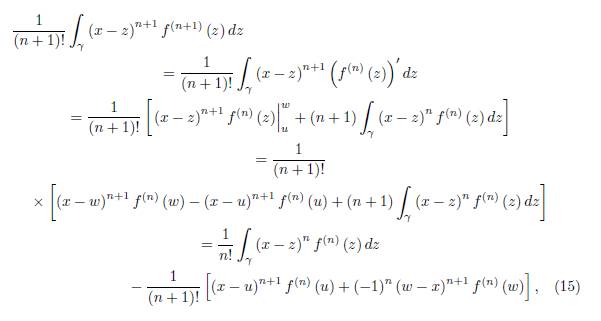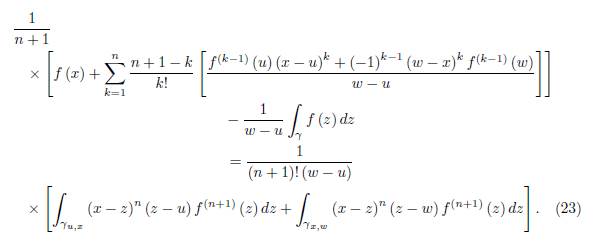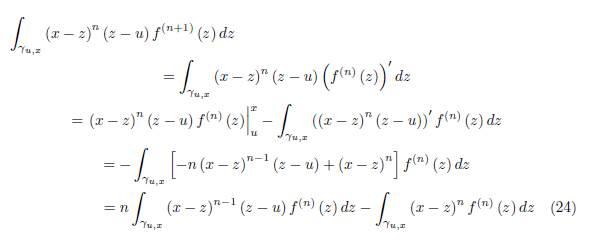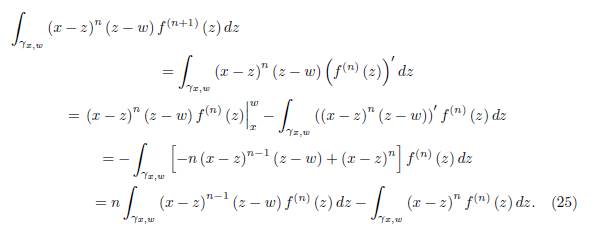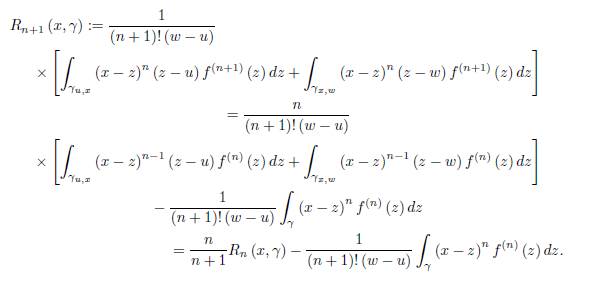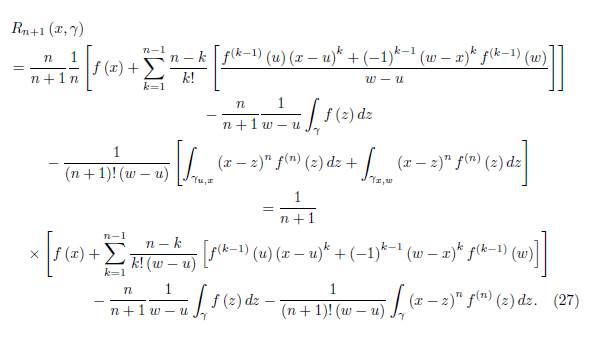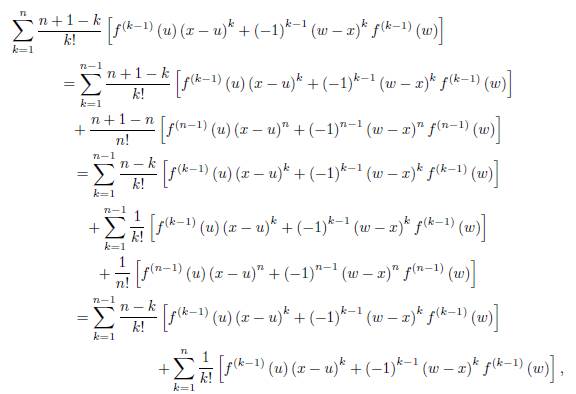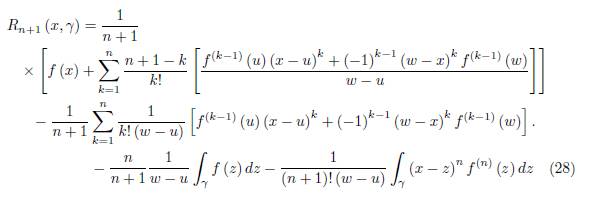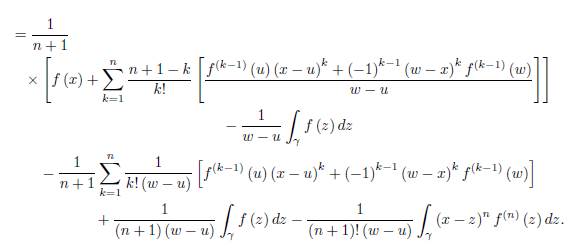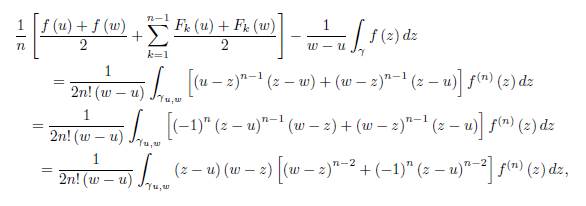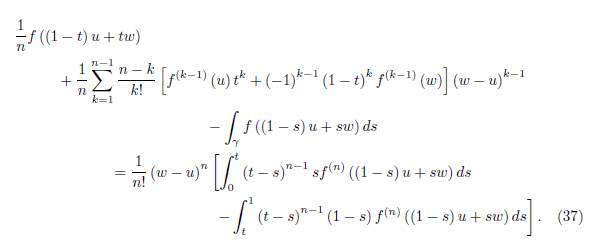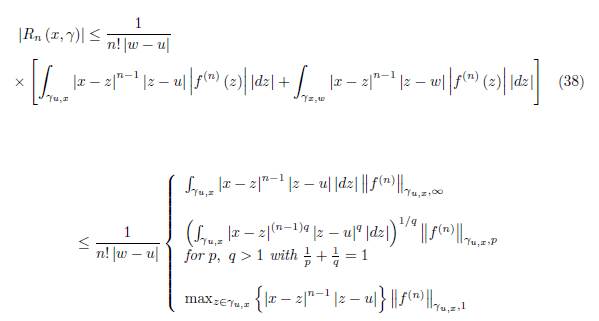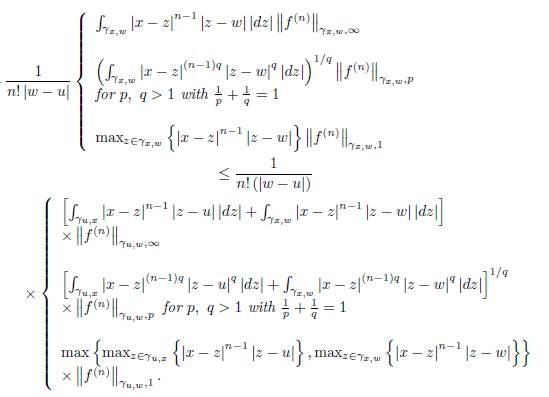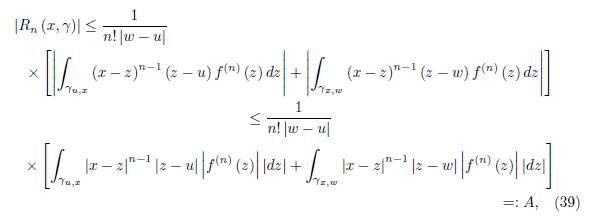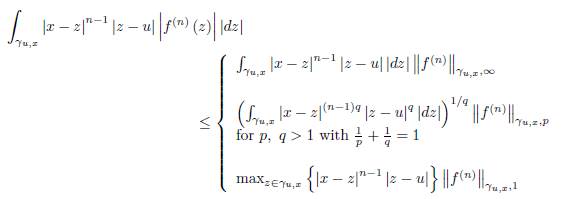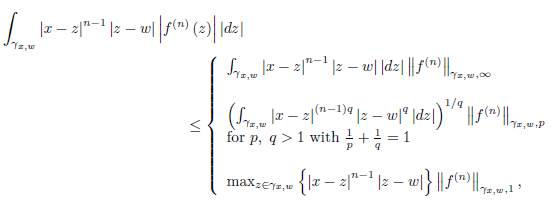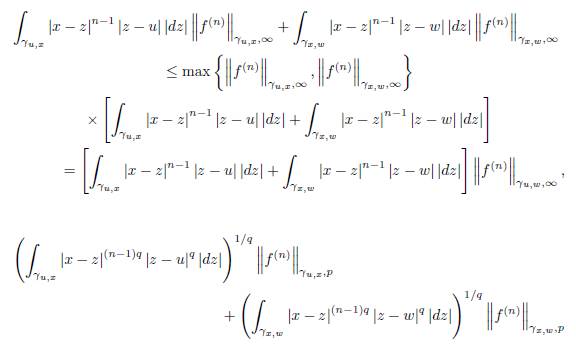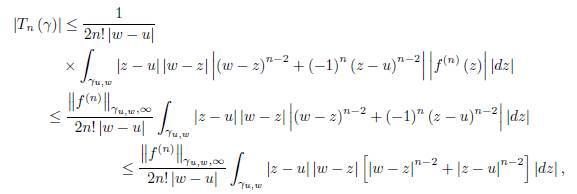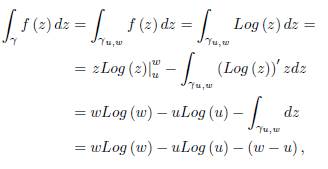1. Introduction
In 1992, [6] A. M. Fink obtained the following identity for a function f: [α, b] → ℝ whose (n − 1)-derivative f (n−1) with n ≥ 1 is absolutely continuous on [α, b]
for x ∈ [a, b] , where
for k = 1, ..., n − 1 where n ≥ 2, and
If n = 1 the sum Σ n−1 k=1 F k (x) is taken to be zero.
In the case f (n) ∈ L∞ [a, b] , namely
then the following bound for the remainder obtained by Milovanović and Pečarić in 1976, [8] holds
In the case of f (n) ∈ L p [a, b] , p ≥ 1, namely
then the following bounds for the remainder obtained by Fink in 1992, [6] hold
For other results connected with Fink’s identity, see [1], [2], [3] and [7].
In order to extend these results for the complex integral, we need the following preparations.
Suppose γ is a smooth path parametrized by z (t) , t ∈ [a, b] and f is a complex function which is continuous on γ. Put z (a) = u and z (b) = w with u, w ∈ ℂ. We define the integral of f on γ u,w = γ as
We observe that the actual choice of parametrization of γ does not matter.
This definition immediately extends to paths that are piecewise smooth. Suppose γ is parametrized by z (t), t ∈ [a, b], which is differentiable on the intervals [a, c] and [c, b], then assuming that f is continuous on γ we define
where v: = z (c) . This can be extended for a finite number of intervals.
We also define the integral with respect to arc-length
and the length of the curve γ is then
Let f and g be holomorphic in G, an open domain and suppose γ ⊂ G is a piecewise smooth path from z (a) = u to z (b) = w. Then we have the integration by parts formula
Where
We also define the p-norm with p ≥ 1 by
For p = 1 we have
If p, q > 1 with
 , then by Hölder’s inequality we have
, then by Hölder’s inequality we have
For p = ∞ the norm is defined by (8).
In the recent paper [4] we obtained the following identity:
Theorem 1.1. Let f: D ⊆ ℂ → ℂ be an analytic function on the domain D and x ∈ D. Suppose γ ⊂ D is a smooth path parametrized by z (t) , t ∈ [a, b] with z (a) = u, z (t) = x and z (b) = w where u, w ∈ D. Then we have the equality
where the remainder On (x, γ) is given by
and n is a natural number, n ≥ 1.
The remainder On (x, γ) satisfies the following bounds
In this paper, we established an identity of Fink type for approximating the integral of analytic complex functions on paths from general domains. Error bounds for these expansions in terms of p-norms were also provided. Examples for the complex logarithm and the complex exponential were given as well.
2. Representation Results
We started with the following preliminary result that was of interest in itself [4]. For the sake of completeness, we gave here a short proof as well.
Lemma 2.1. Let f: D ⊆ ℂ → ℂ be an analytic function on the domain D and x ∈ D. Suppose γ ⊂ D is a smooth path parametrized by z (z) , t ∈ [a, b] with z (a) = u, z (t) = x and z (b) = w where u, w ∈ D. Then we have the equality
for n ≥ 1.
Proof. The proof is by mathematical induction over n ≥ 1. For n = 1, we have to prove that
which is straightforward as may be seen by the integration by parts formula applied for the integral
Assume that (12) holds for “n” and let us prove it for “n + 1”. That is, we wish to show that:
Using the integration by parts rule, we have
which gives that
From the induction hypothesis we have
By making use of (16) and (17) we get
which is equivalent to (14).
We have the following generalization of Fink identity for the complex integral.
Theorem 2.2. Let f: D ⊆ ℂ → ℂ be an analytic function on the domain D and x ∈ D. Suppose γ ⊂ D is a smooth path parametrized by z (t) , t ∈ [a, b] with z (a) = u, z (t) = x and z (b) = w where u, w ∈ D, u ≠ w. Define
for k = 1, ..., n − 1 where n ≥ 2.
Then we have the equality
where the remainder Rn (x, γ) is given by
For, n = 1 the identity (19) reduces to
Where
Proof. We prove the identity by induction over n. For n = 1, we have to prove the equality (21) with the remainder R 1 (x, γ) given by (22).
Integrating by parts, we have:
which proves the statement.
Assume that the representation (19) holds for “n” and let us prove it for “n + 1”. That is, we have to prove the equality
Using the integration by parts, we have
And
If we add these two equalities, we get
By dividing with (n + 1)! (w − u) in (26) we get
Using the representation (20) for R n (x, γ) , which is assumed to be true by the induction hypothesis, we get
Observe that
which implies that
Therefore, by (27) we get
We must prove now that
Namely
This however follows by Lemma 2.1.
We have the following trapezoid type representation:
Corollary 2.3. With the assumptions of Theorem 2.2 we have
for n ≥ 2.
For n = 1, we have
Proof. We have
and
for k = 1, ..., n − 1 where n ≥ 2.
From (19) we have
And
If we add the equalities (31) and (32) and divide by 2, then we get
which proves (29).
Remark 2.4. If the function f is of real variable and defined on the interval [a, b] then from (29) we obtain the following trapezoid identity obtained by Dragomir & Sofo in [5]
for n ≥ 2.
If n = 1, then we have
It is natural to consider the case of linear path γ, namely the path parametrized by z (s) := (1 − s) u + sw, s ∈ [0, 1] that join the distinct complex numbers u, w ∈ D. If x = (1 − t) u + tw for some t ∈ [0, 1] , then
for k = 1, ..., n − 1 where n ≥ 2,
and the equality (19) becomes
3. Error Bounds
We have the following error bounds:
Theorem 3.1. Let f: D ⊆ ℂ → ℂ be an analytic function on the domain D and x ∈ D. Suppose γ ⊂ D is a smooth path parametrized by z (t) , t ∈ [a, b] with z (a) = u, z (t) = x and z (b) = w where u, w ∈ D, u ≠ w. Then we have the representation (19) and the remainder R n (x, γ) satisfies the bounds
Proof. By the equality (20) we have
which proves the first inequality in (38).
Using Holder’s integral inequality we have
and
which proves the last part of 38).
We also have
and
which proves the last part of 38).
We have the following error bounds:
Theorem 3.2. Let f: D ⊆ ℂ → ℂ be an analytic function on the domain D and x ∈ D. Suppose γ ⊂ D is a smooth path parametrized by z (t) , t ∈ [a, b] with z (a) = u, z (t) = x and z (b) = w where u, w ∈ D, u ≠ w. Then we have the representation (29) and the remainder T n (γ) satisfies the bounds
The proof follows by the identity (29) by taking the modulus and using the integral properties.
4. Examples for Logarithm and Exponential
Consider the function f(z) = Log (z) where Log (z) = ln |z| + iArg (z) and Arg (z) are such that −π < Arg (z) ≤ π. Log is called the "principal branch" of the complex logarithmic function. The function f is analytic on all of ℂ ℓ : = ℂ \ {x + iy: x ≤ 0, y = 0} and
Suppose γ ⊂ ℂ ℓ is a smooth path parametrized by z (t) , t ∈ [a, b] with z (a) = u and z (b) = w where u, w ∈ ℂ ℓ , u ≠ w. Then
where u, w ∈ ℂ ℓ .
Define
for k = 2, ..., n − 1, where n ≥ 3.
Then we have the equality
where the remainder Rn (x, γ) is given by
If d γ : = infz∈γ |z| is positive and finite, then from (42) we get the inequality
and suppose γ ⊂ ℂ ℓ is a smooth path parametrized by z (t) , t ∈ [a, b] with z (a) = u and z (b) = w where u, w ∈ ℂ ℓ , u # w. Then
for u, w ∈ ℂ ℓ .
Define as
for x ∈ γ, k = 1, ..., n − 1, where n ≥ 2.
Then we have the equality
where the remainder L n (x, γ) is given by
If d γ defined above is positive and finite, then from (42) we get the inequality
Consider the function f (z) = exp (z) , z ∈ ℂ. Then
and suppose γ ⊂ ℂ is a smooth path parametrized by z (t) , t ∈ [a, b] with z (a) = u and z (b) = w, where u, w ∈ ℂ, u ≠ w. Then
Define for x ∈ γ
for k = 1, ..., n − 1, where n ≥ 2.
Then we have the equality
where the remainder E n (x, γ) is given by
Since |exp z| = exp (Rez) and if assumed that for γ ⊂ ℂ we have
then by (50) we get the inequality




































